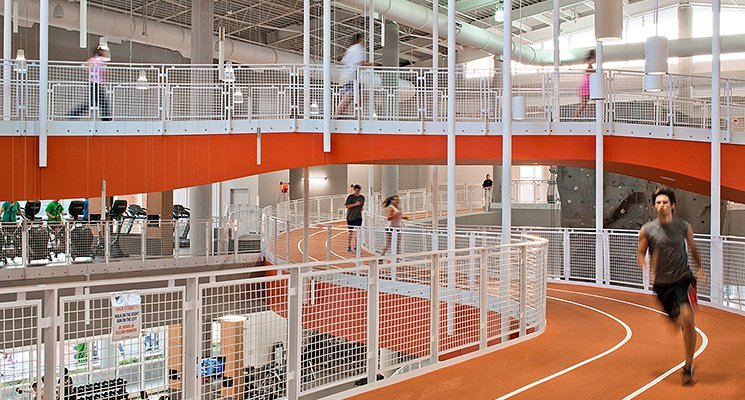Fast Company recently ran an article entitled “A Look Inside the Most Insane College Gyms.” By “insane,” the editors presumably meant equipped with perhaps unnecessary but totally envy-inducing features, such as Louisiana State University’s lazy river in the shape of the letters L, S, and U, for students to float on; Auburn University’s 45-person paw-print shaped hot tub and 20-foot poolside climbing wall; both institutions’ 1/3-mile running tracks, the longest college rec center tracks in the nation (Auburn’s is corkscrew-shaped and winds throughout the rec center building, pictured above; LSU’s is tiger-striped and loops around a rock-climbing wall).
Other features at recently constructed college gyms include ropes and ledges for ascending to the second floor, a skateboard-friendly plaza design (a compromise at Utah State University, after skateboard-friendly walls were deemed impractical), rooftop gardens, and the inclusion of functional training equipment. Under discussion at some universities but not yet incorporated are hot yoga rooms and indoor/outdoor tracks, on which a student could run an indoor loop, head outdoors for fresh air or a nice view, and then follow the track back into the building. Such a structure would include a thermal lock to prevent cold air/hot air exchange.
Now, I’m not saying you should spend millions of dollars refurbishing your facility to incorporate similar features, but I am suggesting that it’s worthwhile to consider the principles behind some colleges’ new “insane” designs, and perhaps to apply some of those principles.
For example, a big catalyst for the over-the-top designs is competition: LSU openly tried to outdo Auburn, its Southeastern Conference rival, when it designed its rec center. Schools try to better each other in the gym department because students often make enrollment choices based on the perceived quality of gym offerings. One recent Purdue University graduate told Fast Company that he chose Purdue partly because he liked that its gym had more options and better hours than the gyms at other universities he considered. The lesson? How your facility compares with others matters.
Another catalyst is envisioning the future. Colleges and universities know that any major rec center renovation or construction plans they dream up now won’t be used until kids currently in eighth grade make their way to higher ed. They need to be forerunners in design trends, and they need to build something flexible enough that it can remain appealing for decades. The lesson? Think not in terms of the now, but in terms of the future. What will customers and members want five, ten, fifteen years down the road? What can you build now that can morph into the next big thing?
A third catalyst is motivating exercisers to push harder. Gyms used to be dark, dank, box-shaped structures with Nautilus equipment and not much else. You couldn’t exactly call their environments inviting. Colleges and universities are looking for ways to make their spaces inviting, to make students want to go to the gym and stay there, to see if they can inspire gym-goers to work out for fifteen minutes longer. With soaring ceilings, light-filled spaces, yoga decks, climbing walls, novelty features (like that “LSU”-shaped floating pool), and other attributes that convey a sense of fun and freedom, institutions are having more and more luck drawing members of their communities to the gym and keeping them there — one recent study found that only 15 percent of students finish their first year of college without ever using the rec center, while roughly 50 percent never use career planning, financial advising, or academic tutoring services. The lesson? The space you offer can invite new members in and encourage retention.
The biggest take-away from all of this? Pay attention to what colleges and universities are doing in their rec centers. Look at photos for inspiration, and keep tabs on new developments. Higher education institutions are at the forefront of gym design — and in a few years their students are going to be young professionals seeking gyms in the real world, and their standards are going to be high.

Back to School: Lessons About Looking Forward
« Blog | | | (0) Comments